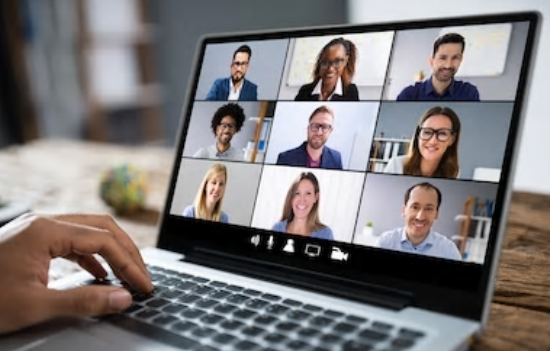Virtual Meeting
Effective Meetings Enabled By Technology
A virtual meeting occurs in a virtual environment that is enabled by technology. This means participants can be located anywhere in the world (or space!) and be able to meet, reconnect, build relationships, discuss issues and make decisions.
A popular example is video conferencing.
Corona Virus (Covid 19)
The video conference meeting is the way people are communicating with each other in this time of Corona Virus or Covid 19. Here you will find support for how you can do this well.
Personal and Family Communication
As a virtual meeting, a video conference is the perfect way to maintain connections with family (sons, daughters, grandchildren) and extended family in these times.

When we are separated, video conferencing is the next best way to connect with loved ones.
Business Communication
If you operate a business or involved in a corporation, you will find here the planning issues to be considered to ensure you can be a persuasive communicator and an effective chair or member of a virtual meeting.
For the business person, check out The Business Virtual Meeting below.
What Is a Virtual Meeting?
Sometimes called virtual conferencing, Virtual Meetings are hosted in a virtual environment and not face-to-face.
In a Virtual Meeting people around the world use video, audio and text to connect regardless of their location.
Two popular forms of a Virtual Meeting are the teleconference and the videoconference.
Videoconferencing has become very popular in recent years.
Easy to setup and use, video conferencing allows a full expression of the visual, auditory and body language.
Two examples of video conferencing are Webex and Zoom.
The Business Virtual Meeting
A virtual meeting is a meeting using technology to bring the participants together other than physically meeting.
As such, the meeting is as real as a face-to-face meeting, it has real people involved, the Agenda and business of the meeting are real, as are the decisions and outcomes of the meeting, the Minutes, the Actions to be followed up

The participants are simply not physically present.
A virtual meeting can be by telephone called a teleconference or by voice and video called a videoconference.
The advantages include the technology enabling meetings where otherwise it might not be possible, savings for meetings, less disruption to a work-day, and responsive and efficient decision making.
Technology used in a Virtual Meeting is an ENABLER. As an enabler technology, it brings people together from possibly “far flung quarters” of the world, in an economical and efficient manner.
The technology produces SAVINGS in:
- Time
- Travel
- Accommodation
- Staff can promptly resume normal work following a meeting
The technology enables:
- Responsive decision making and more effective business to meet a changing business environment.
Business is thus more cost effective and efficient.
The disadvantages include limited non-verbal communications, such as body language and facial expressions. It lacks the warmth of a hand-shake, or the pat on the back, and the standing toe-to-toe with a colleague at a morning tea.
With this in mind, consider your PRESENCE in the meeting.
How do you PLAN a virtual meeting?
A virtual meeting is a meeting using technology to bring the participants together other than physically meeting.
As such, the meeting is as real as a face-to-face meeting, it has real people involved, the Agenda and business of the meeting are real, as are the decisions and outcomes of the meeting, the Minutes and the follow-up.
The participants are simply not physically present.
A virtual meeting can be by telephone called a teleconference (telephones joining participants), or a videoconference with audio and visuals of participants?
The Meeting AIM is communicated to the participants and request for Agenda items is asked for, if this is appropriate.
One week before the Meeting
Send out the meeting resources to all participants by email, website URL or post. These resources could include:
- Agenda clearly numbered and organised for easy meeting reference
- the date and times - convert for International participants
- numbers to be rung if a line drops out or
- a clear procedure if line drops out
- your contact number
- all partcipants names, location, position.
- all resources clearly numbered and referenced (eg slides and pages).
- how to log on details (most important).
At the Meeting
1. Be early: Arrive early and be organised with your Agenda, meeting resources and your favourite beverage (coffee, tea or water etc).
2. Meeting Start: Commence the meeting with a checkin. This is also a quick familiarisation of voices if a teleconference . An international or national checkin could also include a quick comment on the local weather.
If a teleconference, it would be good to ask each participant to say their first name each time they speak for the first four times they speak or for the first 15 minutes.
2. Effective communications: If feasible, establish a code of communications which suggests a way to interject, comment or question. This could be to ask the Chair, eg “excuse me Warren” or “Warren can I suggest”.
Ask for agreement, or for alternate suggestions.
This is done up-front and then will facilitate good discussion without rudeness or aggression.
Remember this is a virtual meeting with no body language or facial expressions (if teleconference) and limited body language (if videoconference), and you may have international attendees.
3. Good meeting management also suggests to:
- Keep to the Agenda
- Stay on time and pace the discussion.
- Repetition: repeat key comments
- Questions: continually ask if there are any questions or if anything needs to be clarified
- Review and summarise periodically or at least after each agenda item.
Be clear and in-agreement:
Aim to ensure everyone understands, decisions are clear and unambiguous.
Aim to have all participants involved, and periodically ask for one participant's opinion. This ensures all are listening and involved.
Today we have many electronic tools available to us. Use with discretion and consider the barriers to an international participant. It may be that such tools actually help to overcome such barriers.
A good example of such a tool is the simple posting of decisions against the Agenda items as soon as they are made. These can be notes, and verify the decision and expedites the Meeting Minutes/Record to be forwarded after the meeting. See After the Meeting below.
After the Meeting
The Meeting is the first part of the decision-making process.
Next, the Meeting Minutes/Record needs to be circulated within 24 hours to be effective. Longer than this and the decisions can have reduced urgency and impact. Being known for effective meetings assists YOUR leadership, whether you are a Team Leader, the CEO or a meeting Member. Effective meetings, decisions, and followup (including Minutes) will stand you in good stead in your career.
Along with the meeting notes on decisions, the Minutes constitute a powerful reinforcer of decisions and ensures decisions are accurately represented and unambiguous (at least this can be an outcome and is up to the writer and Meeting Chair to ensure it is so).
Good Minutes means meeting Members are empowered with direction and efficient use of time knowing they have not misinterpreted a meeting discussion and what is required.
In conclusion
A meeting of real people, using real Agendas, to make real decisions about real problems. The technology is truly a powerful enabler when we appreciate what it can do for us, and understand its current limitations.
Now have a look at What is Video Conferencing and Teleconferencing ...
HAPPY Virtual Meeting ....
Return from Virtual Meeting to Persuasive Speeches HomePage
This article was printed from Persuasive-SpeechesNOW.com




